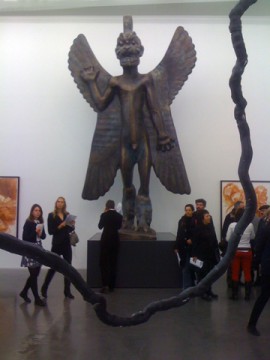
Robert Cuoghi, "Pazuzu," 2008. Epoxy, solvent varnish, fiberglass, polystyrene, and steel. Installation view, New Museum, New York, NY. (Foreground: Urs Fischer, "Cioran Handrail," 2006. Epoxy resin, pigment and enamel) Photo: Kevin McGarry.
This morning I previewed the hotly anticipated exhibition at the New Museum of Greek collector Dakis Joannou’s art holdings, impishly titled Skin Fruit and curated by Jeff Koons. I’ve been looking forward to this show largely due to the controversy surrounding it and the intrigue presented by the curator/collector pairing. However, I’m happy to report that my journey up and down the museum’s galleries wowed me as a genuine art experience, independently of any provocations external to the art itself.
Beginning on the fourth floor via elevator, I was greeted to my right by a larger-than-life, mannequin-ish sculpture of a glamorously conservative blonde businesswoman by Charles Ray (Fall ’91, 1992). To my left, Liza Lou’s Super Sister (1999), nearly as tall, is coated in rhinestones and sports skin color, an afro, tight little clothes, and a gun. The two stand as polar stereotypes of empowered contemporary/American women. This slash between words points to a wide open but unresolved, era-defining ambiguity: which empire does the curator (does anybody) have in mind? Is it America, the international contemporary art world, or the latter as a product of the former? That is, visual culture as an iteration of the global corporate culture that has, if from one seminal place, radiated from the United States.
The other fully rendered figure in the room—elsewhere in the museum there are plenty more; the show is predicated on the human form in contemporary art—is Robert Cuoghi’s Pazuzu (2008), a mammoth casting of the Assyrian and Babylonian king of the demons best known for possessing Linda Blair in The Exorcist. This is according to the wall text, which also mentions that Pazuzu is a symbol both of hope and of powerful civilizations in final decline: fitting. I found its presence oddly captivating, and as the sculpture was blown up in size from a pendant forty times smaller, its preserved plainness of detail is frightening on a massive scale. Beneath it, the rest of the room is shaded by an abject, eschatological distress.
Terrence Koh’s Untitlted (Chocolate Mountains) (2006) suggests the melting gates of a decadent kingdom. Urs Fischer’s Cioran Handrail (2006), a thick enamel thread suspended in the air, winds through the room like a stroke of history whose engine is out and is twirling to the ground. Charles Ray’s revised Revolution Counter-Revolution (1990/2010) is a grayscale, malfunctioning merry-go-round whose horses are static and whose base rotates unevenly, making rapid plinking sounds like artificial rainfall or the dramatized evisceration of data.
The sculptural works are bounded by wall works which all have parable-like qualities. Kara Walker’s large, gouache-on-paper cameos depict antebellum scenes of impending violence between couples whose power dynamics are perversely mismatched. In Paul Chan’s Orgy Before Man and Storm (2003), a scene of debris and identity-positive sex acts between all ages and races centers around interlocked figures appropriated from Matisse’s The Dance, perhaps proposing that progressive social politics that are nevertheless hedonistic are, ultimately, blinded by a sense of utopia. Tauba Auerbach’s Crumple VI (2008) is a large neo-Op Art painting whose black and white Benday dots produce the image of a crumpled sheet of paper from a distance, and a viscerally destabilizing experience for any viewer who gazes upon it up close.
Tucked down the a hall in the corner of the room is, in utter simplicity, Robert Gober’s Corner Bed (1987). The piece is a neatly made counterpoint to the monstrous forms that surround it.
Filled with big objects alluding to a crashing civilization, the mood of Skin Fruit’s fourth floor is distinctly monumental. The obvious irony is the legacy of the museum’s inaugural Unmonumental exhibition that occupied the same space two years ago, and the tension between the two linguistically opposite spirits of production maintains itself throughout the lower floors of the exhibition.




Pingback: What’s Cookin at the Art21 Blog: A Weekly Index | Art21 Blog
Pingback: What’s Cookin at the Art21 Blog: A Weekly Index | Art21 Blog
Pingback: Pardon this Brief Commercial Interruption: Intro | Art21 Blog